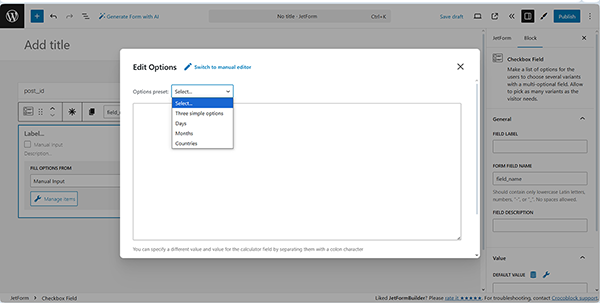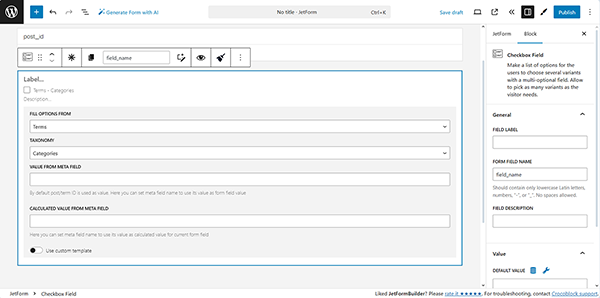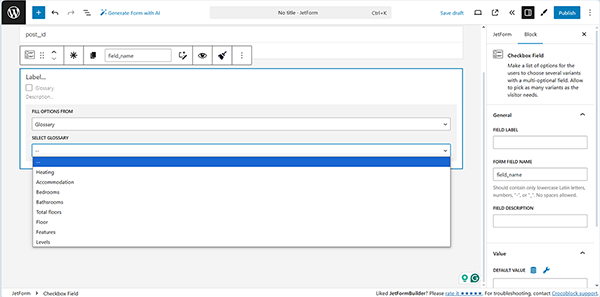Multi-Optional Field Source Settings
The Multi-Optional Field Source is a setting for the Select, Radio, and Checkbox Fields that allows users to choose one or more options from a pre-existing list.
This setting can be used for displaying entered text (“Manual Input” option), meta fields or Custom Post Type (CPT) data to automatically create a list of options (“Posts,” “Terms,” “Users,” “Meta Fields” options), automatically generated data or data taken from the site’s database (“Generate Dynamically” option), taken from the glossaries, and more.
After inserting the Select, Radio, or Checkbox Fields, the settings will be unrolled by default with the “Manual Input” FILL OPTIONS FROM set.
Multi-optional fields allow users to choose one or several options from the ready-made list – Select, Radio, and Checkbox Fields. These three fields have a similar settings window where you can choose the source of the options that will be available to the users.

The needed option can be chosen in the FILL OPTIONS FROM drop-down list; other settings depend on the specified option.
In this drop-down menu, you can select the source of the options list. You can add options manually or use the pre-made list from custom meta fields.
Manual Input
Once set, the option allows manual list creation by pressing the “Manage Items” button.

To create a list of options for selection, the “+ Add new Option” button should be hit.
The settings are presented by the following “Clone,” “Delete,” and “Switch to bulk editor” buttons and LABEL, VALUE, and CALCULATE fields:

- LABEL 一 a field to insert the name of the option that users see in the list;
- VALUE 一 a field to insert the inner data, the value that corresponds to the option;
- CALCULATE 一 a value from this bar will be taken to the formula, which is calculated by the Calculated Field.
The “Clone” and “Delete” buttons are placed in the top-right corner of the Edit Options pop-up and are intended to make a copy of the created option below and delete the item, respectively.
Also, pressing the “+ Add new Option” button adds another option to the list.
Clicking the “Switch to bulk editor” button opens the Edit Options pop-up, allowing you to add a list of custom or preset choices in bulk.

The following options are available via the Options preset drop-down list:
- Three simple options 一 an option that allows entering custom options in bulk. After selecting it, the following will be added to the text field below:
“First Option : first_option : 1
Second Option : second_option : 2
Third Option : third_option : 3”
where the “First Option” is a LABEL, the “first_option” is a VALUE, and “1” is the value for the CALCULATE field (if such is needed);
- Days 一 an option that inserts the list of weekday names;
- Months 一 an option that inserts the list of the month names;
- Countries 一 an option that inserts the list of country names.
There is the following link and button at the top and bottom of the pop-up, respectively:
- Switch to manual editor 一 a link that allows return to the manual option input window without saving the bulk options field changes;
- Add to the options 一 a button that adds bulk options to the multi-optional field alongside any manually created options one may already have.

Once done, the “Update” button should be pressed.
The “Manual Input” option is often used in forms that allow selection, such as booking forms. More details on using this option can be found in the How to Add and Use a Repeater Field in the Form tutorial.
Also, look through the How to Create Evaluation Forms in WordPress tutorial to learn how to create a bulk option list manually.
Posts
This type of source extracts data from the post or page’s meta fields to automatically create a list of options. If a CPT is created via plugins like JetEngine or ACF, these posts can also be shown.
The following settings can be configured:

- POST TYPE 一 a drop-down list to select the source for the items (e.g., WordPress Posts, Pages, and Media, or the CPTs if available);
- VALUE FROM META FIELD 一 a field to specify the name of the specific meta field of the CPT from which the value will be pulled (if the meta field is available). In this case, by default, the values of the options will be taken from the post or page IDs;
- CALCULATED VALUE FROM META FIELD 一 a field to specify the name of the Calculated Field in the form to include a value from a specific meta field in the formula.
The “Posts” option is often used in forms intended to implement the “Service-Provider” functionality, such as appointment forms. For more details on using this option, refer to the How to Build an Appointment Form tutorial.
Terms
This type of source is intended to build a list from the categories or taxonomies that have already been created. For example, if the WooCommerce plugin is used, a list of product categories can be formed. Also, if the ACF or JetEngine plugins are used and a custom taxonomy is created, it is possible to create a list of content, too.
The following settings are available:

- TAXONOMY 一 a drop-down list to select the type of taxonomy that will be used to create a list. In addition to the default WordPress categories, the tags, navigation menus, link categories, and formats can be selected. The names of the taxonomy items will be used as labels in the list;
- VALUE FROM META FIELD 一 a text field to take the values from a custom meta field added to the taxonomy instead of the default term IDs used as the values for the list items;
- CALCULATED VALUE FROM META FIELD 一 a field to specify the name of the Calculated Field in the form to include a value from a specific meta field in the formula.
The “Terms” option is often used in the corresponding fields of forms for registering or using categorized objects. For example, read about applying the “Terms” option for a taxi site in the How to Create a Taxi Booking Form to learn how to allow choosing categories and display them via the Select Field, and the Insert and Update Term tutorial to know how to manage and display the terms.
Meta Fields
The “Meta Field” option displays the custom meta field data used to create an options list. The information for each post will differ and can be displayed separately from the post’s meta fields, which are created with plugins like JetEngine or ACF.

The option’s setting is presented by the META FIELD TO GET THE VALUE FROM bar, which is intended to add the name of the meta field, or meta field values that can also be used as calculated values.
Generate Dynamically
This source option is intended to create two types of dynamically generated lists. In this case, “dynamically generated” means that it is not taken from the meta fields. The list is created by one of the generator functions that can be chosen.

The following settings can be configured:
- GENERATOR FUNCTION 一 a drop-down list to select the rules of the options list generation. It has such options:
- Numbers Range by meta value 一 an option that creates a range of numbers from 1 to the number in the meta field defined in the FIELD NAME bar. For example, for a meta field named “Available items,” and for the post where the form is placed, it has a value of 5. In this case, the “Numbers Range” will create a list containing numbers from 1 to 5;
- Numbers Range by manual input 一 an option that allows entering into the START OF RANGE and END OF RANGE fields to create a list of numbers. The STEP field defines the gap between numbers in the list. E.g., if you set the “1” in the START OF RANGE, “10” in the END OF RANGE, and “3” in the STEP, the options will be: “1, 4, 7, 10”;
- Get values list from database 一 an option that allows searching the database and shows the list of values of every position with a matching key. After entering the meta key into the FIELD NAME bar, the search will be provided. In this case, the database fields with that key should be created before using this function;
- Get values list from JetEngine list options 一 an option that allows adding custom meta fields to posts, terms, or users via the Meta Boxes feature of the JetEngine plugin. In particular, the meta key should be inserted into the FIELD NAME bar to get a list from the Meta Box meta fields;
- Get values list from JetEngine Query 一 an option that creates a list of options based on the query results of the custom query built with the Query Builder tool of the JetEngine plugin. This option gets values from any type of custom query (post query, terms query, etc.). For example, a custom query of the Users Query type that filters the user list by a custom meta field can be used to generate a list of users as options for multi-select fields. In particular, in the FIELD NAME bar, the ID of the custom query should be specified. Also, if a Posts Query is used and no calculated value is needed, only the query ID needs to be set. An example for the Posts Query may look like this:
47|ID|post_title|post_author
Where “47” 一 the ID of the custom query;
“ID” 一 an option that provides values, in this case, the post ID;
“post_title” 一 an option that provides labels;
“post_author” 一 an option that provides calculated values.

The generator takes the parameters obtained via the query. In turn, these parameters can be viewed while editing the query.

Other source settings are:
- VALUE FROM META FIELD 一 a field to insert the name of the meta field, instead of the default IDs of that post type’s items are used. Here, another meta field to take values from and type its name can be inserted;
- CALCULATED VALUE FROM META FIELD 一 a field to insert the name of the meta field into this bar, and its values will be used for Calculated Field formulas.
The “Generate Dynamically” option is used, for example, in forms intended to connect user data to Custom Post Types, as described in the How to populate form field with list of users (by user’s role or relation) tutorial.
Glossary
The JetEngine Glossary feature creates a list of options and can be used for different custom meta fields and form fields.

The settings are presented in the SELECT GLOSSARY drop-down list, which allows you to select the required glossary.
More details on adding, configuring, and using glossaries can be found in the How to Add Glossary to Form Fields and How to Import Glossary from the File tutorials. Also, watch the How to work with JetEngine Glossaries video to learn how to display glossaries on the front-end and more.
Inserting Data from the Front End
The “Enable custom option” is available only for the Radio and Checkbox Fields. It allows users to add custom options on the front end. To activate this feature, the “Enable custom option” button should be pressed.

For the Radio Field, the input field will be added on the front-end as one of the options.

For the Checkbox Field, the “+ Add New” button appears on the front end to add a custom option to the list. Also, the BUTTON LABEL field to customize the corresponding text will be added to the Checkbox Field Block settings on the Value tab.

That’s all about configuring the Multi-Optional Field Source settings of the Select, Radio, and Checkbox Fields of the JetFormBuilder plugin for WordPress to display data entered manually, automatically generated, and from meta fields.